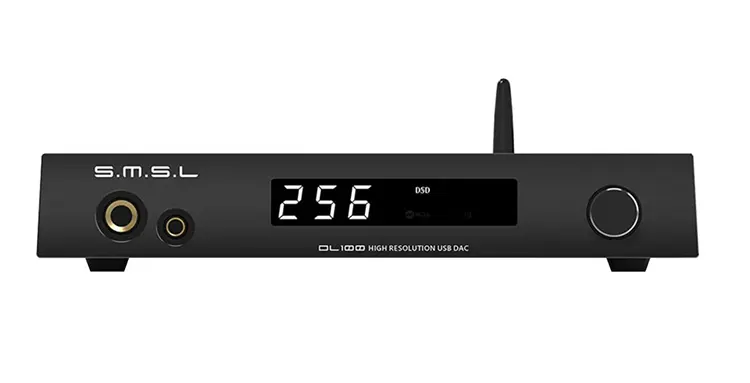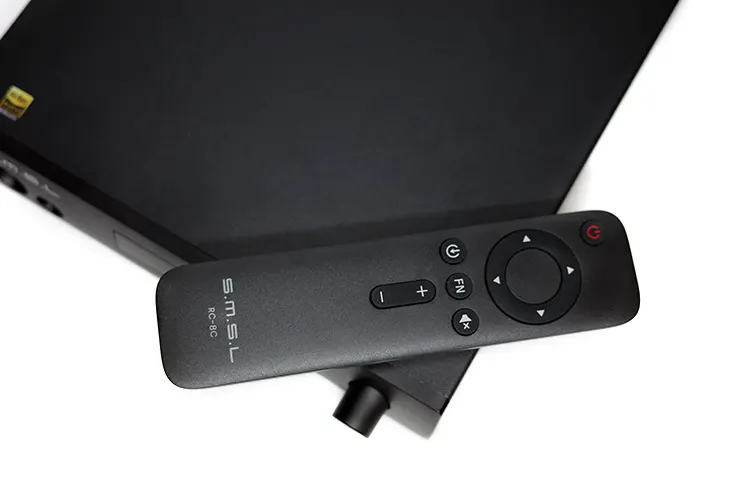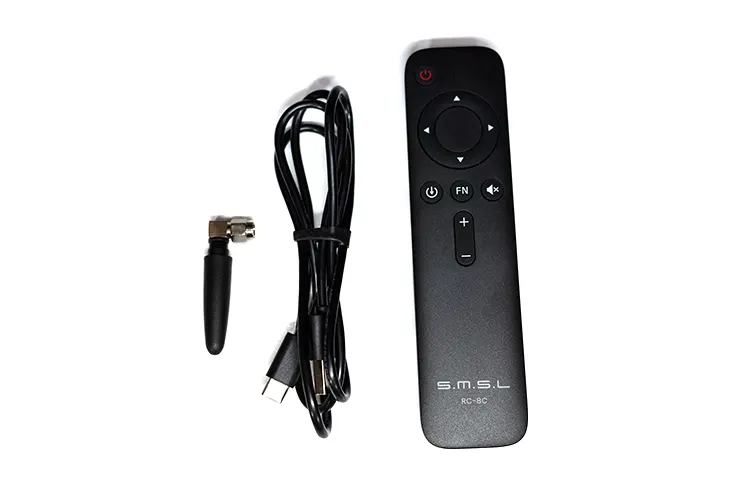In this feature, Lynn reviews the SMSL DL100, a compact and affordable integrated desktop quad-CS43131 DAC and 3W-capable amplifier. It is priced at $179.99.
Disclaimer: This sample was sent to me in exchange for my honest opinion. Headfonics is an independent website with no affiliate links or partnerships. I thank Hifi-express and SMSL for their support.
Click here to learn more about the SMSL products we previously reviewed on Headfonics.
Note that this article follows our current scoring guidelines which you can find in more detail here.
We have reviewed many affordable desktop SMSL products such as the SU-1 and the DO100 DAC, but this is my first foray into the marque for some time.
Having reviewed several of their competitors, I am familiar with the brand though, and have a few units here at my disposal to compare it with.
The unit with me today is their recently launched DL100, a compact desktop integrated DAC and headphone amplifier, priced at $179.99.
It comes with a couple of neat tricks, which the company hopes will provide the DL100 with a unique feature set distinct from an otherwise competitive crowd.
These include an HDMI connection (ARC) and XLR outputs for connecting to your favorite desktop amplifier and BT for wireless connection.

Features
With 4 CS43131 chips, labeled as 2024’s first quad-chip, and TI’s OPA1612A Op-amps, the DL100’s DAC can offer a wide range of digital connections, including an HDMI (ARC) cable.
Along with a dual USB connection (1.1 & 2.0 for easy game system connection), it makes the DL100 a potential system choice for HDMI ARC TV users
The third generation XMOS XU-316 is capable of DSD Native 256, PCM up to 32bit/768kHz, and DoP64. The DL100 also carries more power than its cousin the M300SE by approximately 16 times at 300Ω.
Five PCM filters allow for personalization ranging from NOS (no sampling), FL1 (Fast and Low-latency), FL2 (Fast and Phase-compensated), FL3 (Slow and Low-latency), to F4 (Slow and Phase-compensated).
That DL100’s amplifier can deliver up to 1.5W at 32Ω and 3.0W at 16Ω making it adequately powerful on its own. The power implementation is also kept separate from the DAC circuitry, which helps keep potential interference to a minimum.
The Qualcomm QCC5125 BT 5.1 module supports LDAC, aptX, aptX HD, AAC, and SBD giving you all of the common wireless codecs at your fingertips.
Design
There is no getting around the diminutive size of the DL100, especially with how thin it is, height-wise. This can give the user many beneficial options for placing the unit within their system.
The matte black finish on all sides makes for an unassuming piece of gear too, which means it can go about its business without drawing too much attention to itself.
With its 196 x 31 x 206mm diminutive size (7.7×1.2×8.1in) and weighing in at a little over a kilo at 1.05kg (2.31 lbs.), the DL100 is quite a compact little integrated desktop DAC and headphone amplifier.
The slightly canted sides also remind me of the YULONG DA-ART Aquila series. I find this shape helps me grab hold of the DL100 when necessary and if anything, it has a slightly different look than a regular black rectangular hifi box.
I/O
The front carries a 6.35mm single-ended and 4.4mm balanced PO, a larger LCD screen, and a multi-function volume knob from left to right.
Proportionally the spacing is quite good to me, except the beveled edges of the headphone jacks which do not allow many of my thicker-jacked headphone cables to fit. I even had an issue with the PLUSSOUND Copper XL aftermarket IEM cable, making it useless with the DL100.
The back has the power socket, BT antennae, and USB-C connections which are beside the HDMI ARC connection with an optical input above it to the right of the BT antennae. Lastly, the RCA output jacks are flanked on either side by the XLR balanced output jacks.
While minimal in size, the layout is logical with access to all connections and usable at the same time.
There is no dedicated power switch, but you use the included remote for power and to access the various menus. Coincidentally, I found that the remote works across many SMSL devices at the same time which is a nice benefit.
Controls
The multi-function volume knob allows access and rotation between options such as connectivity and filter choices. The lettering is large and legible thankfully, but I ended up using the remote more to see how good it could work. The remote gave me all of the options I needed.
As mentioned, the 4.4mm balanced output was not usable with cables that carried a thicker jack, making it useless for many cables I own, both stock and after-market. However, I think the DL100 is oriented more towards IEMs than headphones.
The one-way 5.1 BT connected easily and would automatically reconnect when powered back on if that source also had its BT turned on.
Most devices now do this, but it is still a nice feature. That said, if you have a streamer connected to your system you may have to reconnect your source if both are turned on.
Packaging & Accessories
It seems that most manufacturers are getting the fact that we prefer protective packaging, but do not use too many resources in doing so.
The SMSL DL100 comes in a white box, with the contents protected by medium-soft foam inserts for the DL100 and power cord, manual, and BT antennae to sit in.
I appreciate the protective nature of the packaging and do not wish for anything extra, since most of us have plenty of cables sitting around.
Sound Impressions
Listening was conducted with the Spirit Torino Twin Pulse Beryllium IEM, the Shanling MG100, and the QoA Aviation. All three were used with the 4.4mm balanced jack. The headphones used were the Meze Audio 99 Classics using the ddHiFi BC-150B cable with a 4.4mm balanced jack.
Sources included my MacBook Pro, the Shanling M6 Pro, and the Oppo BDP-83. I also connected the Geshelli Labs Erish2 as a headphone amplifier to test the DL100 DAC.
Summary
The sound emanating from the DL100 varied by source input naturally, and the music source coming from each. I did prefer the balanced output for listening. The balanced option helped to spread the soundstage out, allowing the instruments to exercise in their own space.
The DL100 promotes a neutral signature, displaying warmth and richness only if the source or music played does so. This comes across as one of the more neutral DAC/amps I have tried of late.
Its lows offer aplomb when called upon, but without bloating the sound, or carrying over into the mids, which I appreciated. The top end reach will add a bit of sparkle and a distinct clarity to the notes, but without becoming grating or harsh.
Timbre
The SMSL comes across as neutral, but not boringly analytical. The quad DACs (two per channel) help to keep the music in perspective, without coloring the sound.
Promoting a very realistic tonality, it’s the headphones, IEMs, or sources used that will provide the coloration here. The upper end of the music spectrum comes out further reaching than the lows do down below allowing the extension to broaden the height nicely.
The midrange shows good detail, especially in acoustic guitar music to the point where the strumming can be heard adding to the experience. This lends an accuracy to the detail that might not come about from something in this range. While not extraordinary, it is still good.
This is something I appreciate, and normally I like a bit of warmth or richness to the sound from devices such as this. However, hearing strong male vocals through the Oppo as they are meant to be on CD makes me appreciate the DL100 for what it does and doesn’t do.
Note quality is strong without becoming strident or stringent. Speed is the key here, showing that a quick attack and decay can provide accuracy without becoming truncated as some do in the same situation.
Staging & Dynamics
The soundstage is dependent upon the source for expression, but the width and height coming from the DL100 are quite broad. The depth comes across as a bit shallow, but not to the point of compressing the music fore and aft.
Dynamics are allowed to spread out with good note weight and the right amount as well. If the note weight becomes too thick, the sound slows down, becoming less accurate and cumbersome. The DL100 prevents this by keeping the weight just right but giving a good heft across the sound spectrum.
I will say that connected to the Oppo BDP-83 I was astounded by the combined performance and appreciated what could be had from such a diminutive product in characteristics and cost.
The OPA1612a Op-Amps did their job here by providing more than adequate power for anything I threw its way.
Click on page 2 below for my recommended pairings and selected comparisons.





